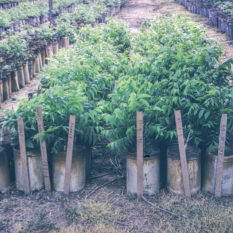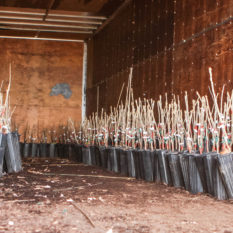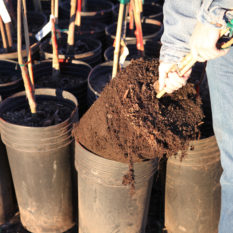Container versus Bareroot Pecan Trees
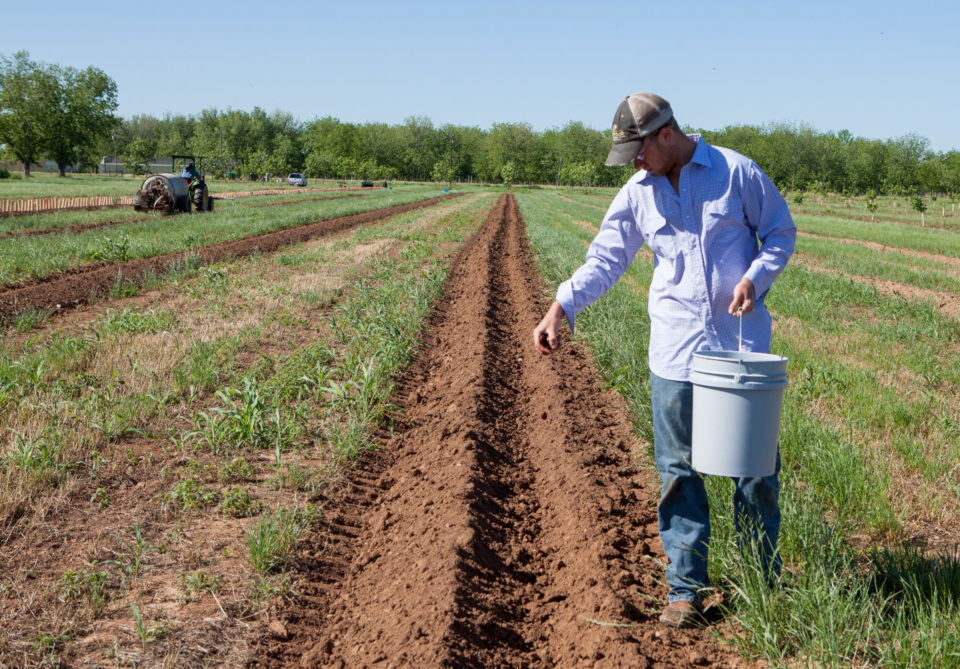
Zac Swick plants pecan seed in a nursery row at the Texas A&M Farm. We no longer plant pecans by seed in orchards as it is too slow and expensive.
Historically there were three options for planting a pecan tree: pecan seed, a nursery-grown grafted variety tree, or a seedling tree, which would be grafted two to three years later. The seeds in place system died 50 years ago because it was too slow, too difficult to keep the little trees alive, and too expensive. The grafted nursery tree and seedling tree systems are both used today on small orchards of less than 10 acres. For commercial orchards the nursery grafted tree is the feasible system used today.
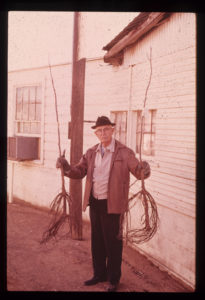
The late O.S. Gray of O.S. Gray Nursery and Landscape in Arlington, Texas, shows the strong roots of a bareroot pecan tree.
Fifty years ago, all commercial orchards were planted as bareroot trees with a 3- or 4-year-old root system and a 1-year-old variety scion or top that was 6 to 10 feet tall. Large commercial nurseries produced these trees from New Mexico to South Carolina. The trees were dug with a large U blade in front of a large bulldozer which lifted the young trees out of the nursery row one tree at a time.
About 40 years ago, in the humid Southeast, some nurseries began growing nursery trees in 4-gallon plastic containers using overhead sprinkler irrigation. Growing container trees was a slow-developing industry because it was hard to keep the trees in good health 365 days of the year and they were difficult to graft.
Dr. Earl Puls of Louisiana State University developed a pecan container production system at Hammond, Louisiana, with an artesian water well with a high-quality and unlimited supply. He started the nuts in a raised bed and transplanted them into 4-gallon plastic containers after one year’s growth. He grew the small seedling trees in containers, and they proliferated their second year. During the third year, the seedling trees were grafted in late winter or early spring when the stem diameter was third-eighth of an inch or larger. Using a direct graft, he moved dormant scion variety graft sticks from the mother tree to the container tree in the same day.
Thurman Gibson, Glenn Huddleston, and I tried to copy this system in Palestine, Texas but failed because we could not learn the secrets of this direct grafting. Amazingly, Earl Puls had very high success; and unfortunately, he passed away before we learned how to do it.
Fast forward to 2020, many nurseries now grow pecan trees in containers. A grower now has the choice of planting a container tree versus a bareroot tree. The two systems look alike from the graft up, but the roots are quite different.
The advantage of the bareroot tree is the food supply in the large taproot system. Bareroot trees can be bundled with moist packing material, wrapped with burlap cloth, and shipped long distances without tree survival loss. The shoot to scion ratio for bareroot trees is significant as the root is two or three times larger than the scion top.
For container trees the opposite can be the case, where the scion variety top is larger than the roots in the container. Container trees have a circle of roots in the bottom of the plastic container, and these roots can be large. Although the container-grown trees have much less taproot, they develop many tiny feeder roots that bundle together in the potting soil mix. In contrast, bareroot trees have few or no tiny feeder roots. These feeder roots are the key to growing a large top in the nursery. Overhead sprinkler irrigation with slow-release fertilizer in the nursery plus side dressing with nitrogen is what pushes the large scion variety tops. In addition, container trees grow in a high oxygen soil mix, which demands two or three irrigation cycles every 24 hours even in a humid climate.
At planting we cut the scion variety top back 50 percent for both bareroot and container trees. For bareroot trees, we want to save and plant as much root in the soil as possible. Side roots are cut back to fit the size of the planting hole. Container trees have fewer roots and the top must be cut back for a balance in the root to shoot ratio.
For planting container trees, there are two schools of thought: leave the circle of roots in the bottom alone or prune the circle of roots to stimulate new lateral roots. At Mississippi State University in the 1970s, Professor Gene Overcash researched cutting the circle of roots on container trees and found no difference in tree growth following planting. His no-prune-root trees and the pruned-root trees from container trees had the same growth and survival.
Today, when all is said and done, there is no difference in tree growth when pecan orchards are planted with bareroot or container nursery trees. However, container trees will require diligent irrigation and weed control, while properly planted bareroot trees can survive and grow with normal attention to management.

